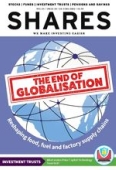Archived article
Please note that tax, investment, pension and ISA rules can change and the information and any views contained in this article may now be inaccurate.
The earnings downgrade cycle has only just begun, suggesting more pain ahead

Up until last week’s (ended 24 June) gain the US benchmark S&P 500 index had dropped in 10 of the prior 11 weeks and entered bear market territory which is a 20% drop from the prior peak.
While share prices have dropped, earnings forecasts from analysts have barely moved. This means the forward price to earnings ratio has shrunk from around 21 times to 16.5 times which perhaps suggests the ‘bottom’ may not be far away.
However, before investors get too carried away it is worth remembering that the market’s PE ratio has only shrunk in line with the rise in long-term interest rates.
In other words, the fall in the PE can be explained by the rise in 30-year interest rates from 2% in January to 3.3% today which theoretically lowers the price that investors are willing to pay for company earnings.
A similar pattern has emerged in Europe where the PE has dropped by around 30% from its peak, according to Morgan Stanley equity strategist Graham Secker.
MSCI European stocks have performed better in relative terms than their US counterparts as they are only 17% below the peak. A lower starting PE may explain some of the outperformance.
Secker points out the drop seen in the MSCI Europe’s forward PE ratio has only been succeeded by the 2008 financial crisis and the bursting of the dotcom bubble in the early 2000s.
However, Secker notes that ‘while we may be in the later stages of the valuation derating this does not necessarily imply that we are near a market bottom’.
Morgan Stanley’s line of argument is that historically stocks tend to trough two or three weeks before earnings revisions bottom out.
The problem is earnings revisions have only recently started to roll over, leaving plenty of scope for further downgrades to come.
The lack of downgrades seems surprising given that central banks are aggressively raising interest rates and trying to slow demand.
Adding further fuel to the argument, the 17% drop seen in European stocks so far looks modest compared with an average 29% drop since 1990 from peak to trough.
Morgan Stanley expects to see a deterioration in corporate news flow over the next few months which should put pressure on earnings forecasts.
In terms of magnitude, the 20%-plus fall in earnings revisions seen in prior economic slowdowns suggests the current 3% drop has further to fall.
Over the past week the only European sectors to have registered more than a 5% fall in revisions are food retail, construction and consumer durables. In contrast, banks have seen double-digit increases.
Important information:
These articles are provided by Shares magazine which is published by AJ Bell Media, a part of AJ Bell. Shares is not written by AJ Bell.
Shares is provided for your general information and use and is not a personal recommendation to invest. It is not intended to be relied upon by you in making or not making any investment decisions. The investments referred to in these articles will not be suitable for all investors. If in doubt please seek appropriate independent financial advice.
Investors acting on the information in these articles do so at their own risk and AJ Bell Media and its staff do not accept liability for losses suffered by investors as a result of their investment decisions.
Issue contents
Feature
Great Ideas
Investment Trusts
News
- Apple aims to arrest sagging share price as new product launch rumours swirl
- Investment trusts prove to be key sources of dividends
- The earnings downgrade cycle has only just begun, suggesting more pain ahead
- Copper has entered a bear market and history tells us it’s not a good sign
- Why stock markets are taking Russia's debt default in their stride

 magazine
magazine








